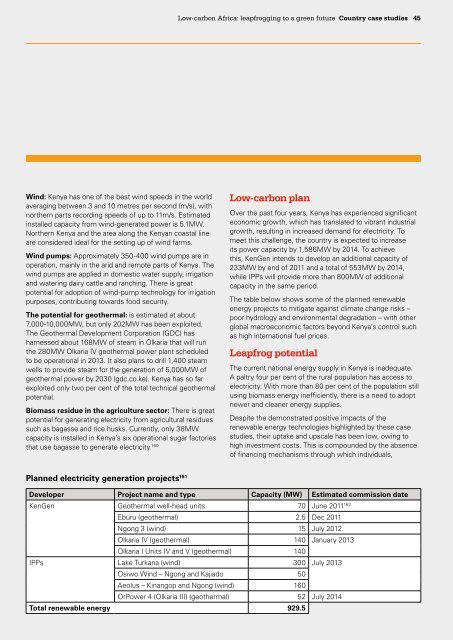Ju8uG
Ju8uG
Ju8uG
Create successful ePaper yourself
Turn your PDF publications into a flip-book with our unique Google optimized e-Paper software.
Low-carbon Africa: leapfrogging to a green future Country case studies<br />
45<br />
Wind: Kenya has one of the best wind speeds in the world<br />
averaging between 3 and 10 metres per second (m/s), with<br />
northern parts recording speeds of up to 11m/s. Estimated<br />
installed capacity from wind-generated power is 5.1MW.<br />
Northern Kenya and the area along the Kenyan coastal line<br />
are considered ideal for the setting up of wind farms.<br />
Wind pumps: Approximately 350-400 wind pumps are in<br />
operation, mainly in the arid and remote parts of Kenya. The<br />
wind pumps are applied in domestic water supply, irrigation<br />
and watering dairy cattle and ranching. There is great<br />
potential for adoption of wind-pump technology for irrigation<br />
purposes, contributing towards food security.<br />
The potential for geothermal: is estimated at about<br />
7,000-10,000MW, but only 202MW has been exploited.<br />
The Geothermal Development Corporation (GDC) has<br />
harnessed about 168MW of steam in Olkaria that will run<br />
the 280MW Olkaria IV geothermal power plant scheduled<br />
to be operational in 2013. It also plans to drill 1,400 steam<br />
wells to provide steam for the generation of 5,000MW of<br />
geothermal power by 2030 (gdc.co.ke). Kenya has so far<br />
exploited only two per cent of the total technical geothermal<br />
potential.<br />
Biomass residue in the agriculture sector: There is great<br />
potential for generating electricity from agricultural residues<br />
such as bagasse and rice husks. Currently, only 38MW<br />
capacity is installed in Kenya’s six operational sugar factories<br />
that use bagasse to generate electricity. 160<br />
Low-carbon plan<br />
Over the past four years, Kenya has experienced significant<br />
economic growth, which has translated to vibrant industrial<br />
growth, resulting in increased demand for electricity. To<br />
meet this challenge, the country is expected to increase<br />
its power capacity by 1,586MW by 2014. To achieve<br />
this, KenGen intends to develop an additional capacity of<br />
233MW by end of 2011 and a total of 553MW by 2014,<br />
while IPPs will provide more than 800MW of additional<br />
capacity in the same period.<br />
The table below shows some of the planned renewable<br />
energy projects to mitigate against climate change risks –<br />
poor hydrology and environmental degradation – with other<br />
global macroeconomic factors beyond Kenya’s control such<br />
as high international fuel prices.<br />
Leapfrog potential<br />
The current national energy supply in Kenya is inadequate.<br />
A paltry four per cent of the rural population has access to<br />
electricity. With more than 80 per cent of the population still<br />
using biomass energy inefficiently, there is a need to adopt<br />
newer and cleaner energy supplies.<br />
Despite the demonstrated positive impacts of the<br />
renewable energy technologies highlighted by these case<br />
studies, their uptake and upscale has been low, owing to<br />
high investment costs. This is compounded by the absence<br />
of financing mechanisms through which individuals,<br />
Planned electricity generation projects 161<br />
Developer Project name and type Capacity (MW) Estimated commission date<br />
KenGen Geothermal well-head units 70 June 2011 162<br />
Eburu (geothermal) 2.5 Dec 2011<br />
Ngong 3 (wind) 15 July 2012<br />
Olkaria IV (geothermal) 140 January 2013<br />
Olkaria I Units IV and V (geothermal) 140<br />
IPPs Lake Turkana (wind) 300 July 2013<br />
Osiwo Wind – Ngong and Kajiado 50<br />
Aeolus – Kinangop and Ngong (wind) 160<br />
OrPower 4 (Olkaria III) (geothermal) 52 July 2014<br />
Total renewable energy 929.5


